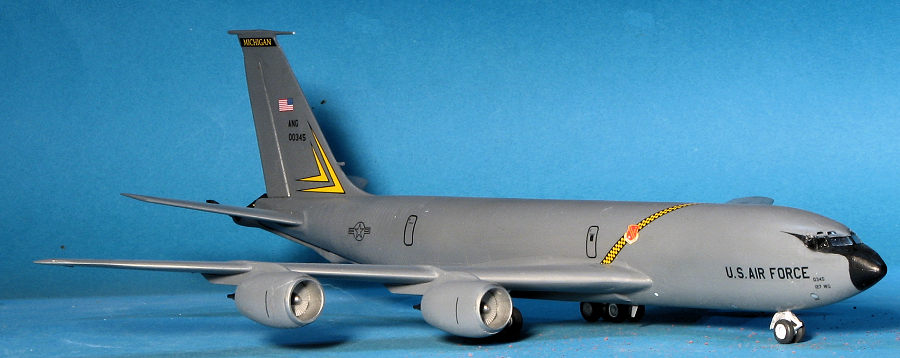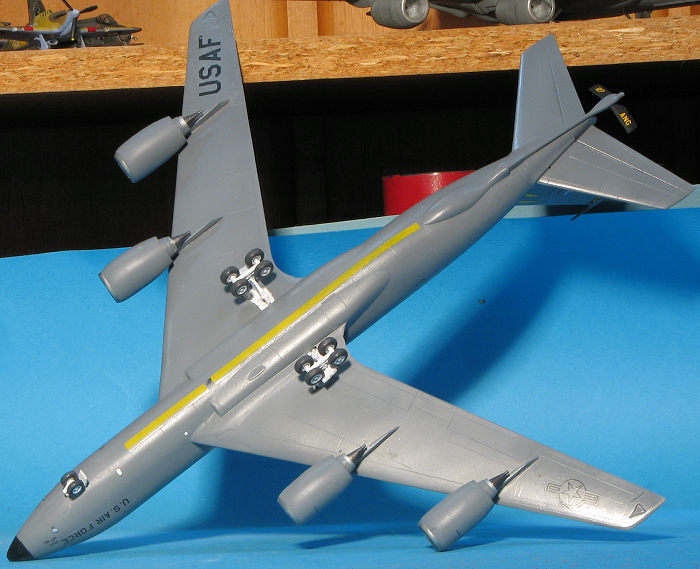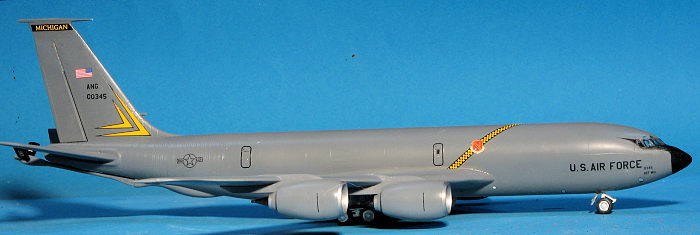
Roden 1/144 KC-135R Stratotanker
| KIT #: | 350 |
| PRICE: | $43.00 delivered from Ukraine |
| DECALS: | One option |
| REVIEWER: | Scott Van Aken |
| NOTES: |

| HISTORY |
The Boeing KC-135 Stratotanker is a military aerial refueling aircraft. It and the Boeing 707 airliner were developed from the Boeing 367-80 prototype. It is the predominant variant of the C-135 Stratolifter family of transport aircraft. The KC-135 was the US Air Force's first jet-powered refueling tanker and replaced the KC-97 Stratofreighter. The KC-135 was initially tasked with refueling strategic bombers, but was used extensively in the Vietnam War and later conflicts such as Operation Desert Storm to extend the range and endurance of US tactical fighters and bombers.
 The KC-135 entered service with the United States Air Force (USAF) in
1957; it is one of six military fixed-wing aircraft with over 50 years of
continuous service with its original operator. The KC-135 is supplemented by the
larger KC-10. Studies have concluded that many of the aircraft could be flown
until 2040, although maintenance costs have greatly increased. The aircraft will
eventually be replaced by the Boeing KC-46 Pegasus, though that will take a long
time as the first production aircraft wasn't delivered to the USAF until January
2019.
The KC-135 entered service with the United States Air Force (USAF) in
1957; it is one of six military fixed-wing aircraft with over 50 years of
continuous service with its original operator. The KC-135 is supplemented by the
larger KC-10. Studies have concluded that many of the aircraft could be flown
until 2040, although maintenance costs have greatly increased. The aircraft will
eventually be replaced by the Boeing KC-46 Pegasus, though that will take a long
time as the first production aircraft wasn't delivered to the USAF until January
2019.
| THE KIT |
This is not the first 1/144 KC-135R, with Minicraft offering the first one. Now we have two of them with this recently released kit from Roden. Actually, the timing is good as Minicraft is no longer a going concern. Just looking over the sprues, it appears that Roden has more accurate engine nacelles and they got the cockpit windows correct. A nice touch on the engines is that the forward cowling is a separate piece so no worries on dealing with a seam.
 Roden has you build up the wings, complete with landing gear before attaching
them to the fuselage. One also builds up the refueling boom at this time. The
final step is to add the wings, tailplanes, fin tip, and the cockpit clear
piece. There is no cockpit with this kit and really none is needed. What is
needed is 20 grams of weight to keep it from tail sitting.
It is fairly obvious from the sprues that the
pieces for the EC-135 are included if you so wish to build that instead. Of
course, you'll need to come up with markings.
Roden has you build up the wings, complete with landing gear before attaching
them to the fuselage. One also builds up the refueling boom at this time. The
final step is to add the wings, tailplanes, fin tip, and the cockpit clear
piece. There is no cockpit with this kit and really none is needed. What is
needed is 20 grams of weight to keep it from tail sitting.
It is fairly obvious from the sprues that the
pieces for the EC-135 are included if you so wish to build that instead. Of
course, you'll need to come up with markings.
Instructions are really nicely drawn though oddly, the inside of the sheet is upside down compared to the outside. There are only 9 construction steps so this isn't a really complex kit. The lone set of markings is pretty boring as it is a shamu scheme aircraft that was assigned to the 42nd BW at Loring AFB. Fortunately, there are aftermarket sheets for more interesting schemes. The sheet looks to be nicely printed, though I have had issues with Roden decals adhering to anything other than a flat surface in the past.
| CONSTRUCTION |
Roden has been around for a while and while I'd like to think they have joined the upper echelon of kit makers, that has not been the case. I've built Roden kits that fit very well and I've built some that have been more like a short run kit in terms of fit. This latter has been the case in every one of the 1/144 kits of theirs I have built and this one turned out to be no exception. Generally speaking the kit lacks positive locators for parts and the large number of sprue gates guarantees you'll be spending a lot of time with sandpaper or files. I also found that some parts needed considerable assistance. However, with the demise of Minicraft, this looks to be, at least for a while, to be the best choice for a 1/144 KC-135.
 I started this one by assembling the engine nacelles. These
are multiple pieces and to say that they fit well would be grossly
misrepresenting the truth. I used much
filler and sanding to get them to come out smoothly. This in effect, removed all
the detail from these items. These are specific for either inner or outer wing
positions with the inner wing pylons having a taller attachment point. Once the
wings were glued together and cleaned up, the openings in the forward wing had
to be enlarged so that the pylons would fit. Getting that taken care of, I moved
to the fuselage.
I started this one by assembling the engine nacelles. These
are multiple pieces and to say that they fit well would be grossly
misrepresenting the truth. I used much
filler and sanding to get them to come out smoothly. This in effect, removed all
the detail from these items. These are specific for either inner or outer wing
positions with the inner wing pylons having a taller attachment point. Once the
wings were glued together and cleaned up, the openings in the forward wing had
to be enlarged so that the pylons would fit. Getting that taken care of, I moved
to the fuselage.
There is no cockpit so one can pretty much assemble the fuselage halves after finding 20g of weight for the nose. The flying boom is supposed to be able to be movable and once trapped between the fuselage halves does move. Actually, it is a very sloppy attachment point so will undoubtedly be glued in place after everything is done. The small nose gear well is to be attached to a fuselage half before closing the halves. There is no real locator for this part so it is hit or miss as to whether it is in its proper place with the halves closed. I had some issue closing the tail halves as one side of the very thin fin was fairly mangled during shipment. I also knocked off the radio antennas molded onto the fuselage. I hate it when kit companies do this. How hard can it be to provide those as separate pieces with a nice attachment stub.
With the fuselage halves together, I attached the tailplanes. These are a fairly loose fit so care needs to be taken when gluing them in place. The fin tip is considerably wider than the top of the fin. Next step was to attach the engines and pylons. I left off the intake and exhaust pieces until after the kit was painted. Fit of the pylons is fairly poor with large gaps that will need to be filled on the upper surface. Probably the worst fitting part of the kit and enough to cause the builder to set things aside for a while. With all that done, the windscreen was masked and I headed for the paint shop.
| COLORS & MARKINGS |
 Before
applying the markings, I felt I should at least get the wheels and gear
doors on. Painting the wheels was a real pain due to their small size. I
also had to trim the nose gear leg and door to get it to fit into the well
opening. Main gear doors fit OK, but not great and there was one door that I
had no idea where it was supposed to fit so left it off.
Before
applying the markings, I felt I should at least get the wheels and gear
doors on. Painting the wheels was a real pain due to their small size. I
also had to trim the nose gear leg and door to get it to fit into the well
opening. Main gear doors fit OK, but not great and there was one door that I
had no idea where it was supposed to fit so left it off. | CONCLUSIONS |
Roden and Minicraft 135Rs

12 April 2024
Copyright ModelingMadness.com. All rights reserved. No
reproduction in part or in whole without express permission from the editor.
If you would like your product reviewed fairly and fairly
quickly, please
contact
the editor
or see other details in the
Note to
Contributors.